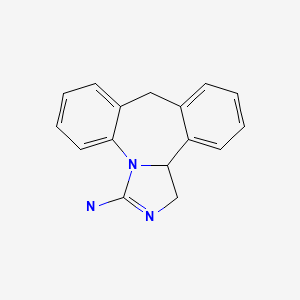Attribution Statement: LactMed is a registered trademark of the U.S. Department of Health and Human Services.
NCBI Bookshelf. A service of the National Library of Medicine, National Institutes of Health.
Drugs and Lactation Database (LactMed®) [Internet]. Bethesda (MD): National Institute of Child Health and Human Development; 2006-.
CASRN: 80012-43-7

Drug Levels and Effects
Summary of Use during Lactation
Evidence from 7 individuals indicates that transfer of epinastine into breastmilk and the resulting infant serum levels are likely to be minimal and unlikely to cause adverse effects in breastfed infants. In the U.S., epinastine is only available as eye drops. Because absorption from the eye is limited, epinastine would not be expected to cause any adverse effects in breastfed infants. To substantially diminish the amount of drug that reaches the breastmilk after using eye drops, place pressure over the tear duct by the corner of the eye for 1 minute or more, then remove the excess solution with an absorbent tissue.
Drug Levels
Maternal Levels. Seven nursing mothers who had taken oral epinastine 20 mg once daily for at least 7 days donated milk samples at 2, 4 and 10 hours after their daily dose. Average milk levels were 17.6 mcg/L at 2 hours, 31.0 mcg/L at 4 hours and 17.2 mcg/L at 10 hours after the dose.[1] Using the highest average milk level (at 4 hours), the maximum dose that an infant might obtain through breastmilk is 2.6 mcg/kg daily or 8.2% of the maternal weight-adjusted dosage. However, if the 2 and 10-hour milk levels are used, the average infant dosage would be 4.6% of the maternal weight-adjusted dosage.
Infant Levels. Two infants who were almost exclusively breastfed were nursed by mothers who had taken oral epinastine 20 mg once daily for at least 7 days. Their plasma epinastine levels were under the quantification limit of the assay, but estimated to be 0.0189 and 0.0449 mcg/L.[1] These values correspond to 0.2% and 0.3% of maternal plasma levels, respectively.
Effects in Breastfed Infants
In a study of 7 nursing mothers who were taking oral epinastine 20 mg once daily. No adverse reactions in the infants were reported.[1]
Effects on Lactation and Breastmilk
Antihistamines in relatively high doses given by injection can decrease basal serum prolactin in nonlactating women and in early postpartum women. However, suckling-induced prolactin secretion is not affected by antihistamine pretreatment of postpartum mothers.[2,3] The prolactin level in a mother with established lactation may not affect her ability to breastfeed. Low ophthalmic doses of epinastine are unlikely to have the same effect on serum prolactin.
Alternate Drugs to Consider
References
- 1.
- Iwasa C, Zaima K, Metori K, et al. Transfer of epinastine to infants through human breast milk. Pharmazie. 2019;74:732–6. [PubMed: 31907112]
- 2.
- Messinis IE, Souvatzoglou A, Fais N, et al. Histamine H1 receptor participation in the control of prolactin secretion in postpartum. J Endocrinol Invest. 1985;8:143–6. [PubMed: 3928731]
- 3.
- Pontiroli AE, De Castro e Silva E, Mazzoleni F, et al. The effect of histamine and H1 and H2 receptors on prolactin and luteinizing hormone release in humans: Sex differences and the role of stress. J Clin Endocrinol Metab. 1981;52:924–8. [PubMed: 7228996]
Substance Identification
Substance Name
Epinastine
CAS Registry Number
80012-43-7
Disclaimer: Information presented in this database is not meant as a substitute for professional judgment. You should consult your healthcare provider for breastfeeding advice related to your particular situation. The U.S. government does not warrant or assume any liability or responsibility for the accuracy or completeness of the information on this Site.
- User and Medical Advice Disclaimer
- Drugs and Lactation Database (LactMed) - Record Format
- LactMed - Database Creation and Peer Review Process
- Fact Sheet. Drugs and Lactation Database (LactMed)
- Drugs and Lactation Database (LactMed) - Glossary
- LactMed Selected References
- Drugs and Lactation Database (LactMed) - About Dietary Supplements
- Breastfeeding Links
- PubChem SubstanceRelated PubChem Substances
- PubMedLinks to PubMed
- Review Azelastine.[Drugs and Lactation Database (...]Review Azelastine.. Drugs and Lactation Database (LactMed®). 2006
- Review Ketotifen.[Drugs and Lactation Database (...]Review Ketotifen.. Drugs and Lactation Database (LactMed®). 2006
- Review Levocabastine.[Drugs and Lactation Database (...]Review Levocabastine.. Drugs and Lactation Database (LactMed®). 2006
- Review Flurbiprofen.[Drugs and Lactation Database (...]Review Flurbiprofen.. Drugs and Lactation Database (LactMed®). 2006
- Review Loteprednol.[Drugs and Lactation Database (...]Review Loteprednol.. Drugs and Lactation Database (LactMed®). 2006
- Epinastine - Drugs and Lactation Database (LactMed®)Epinastine - Drugs and Lactation Database (LactMed®)
Your browsing activity is empty.
Activity recording is turned off.
See more...
